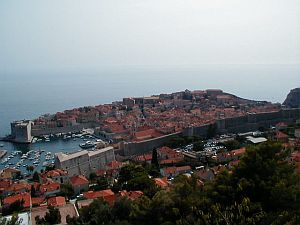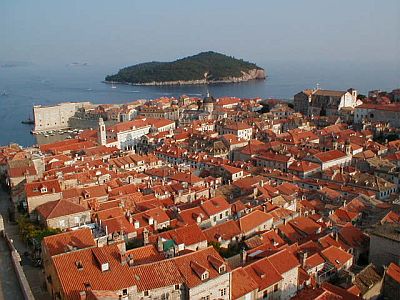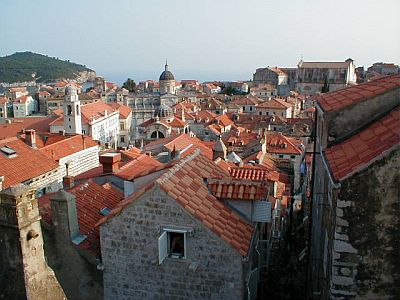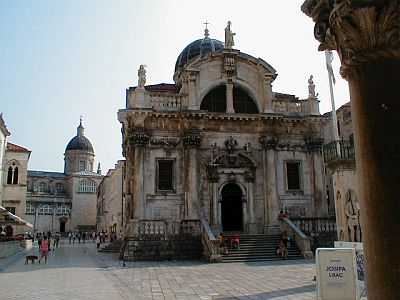Official Name
Dubrovnik. Until 1918, the town was known as Ragusa. Nowadays, Dubrovnik carries the beautiful nickname Pearl of the Adriatic Sea. "Dubrova" is a Slavic word and means 'grove' or 'thick forest' - however, there aren't any groves or forests nearby, so I'm not sure whether the name has something to do with 'dubrova'. Eversince, the word Dubrovnik referred to the Slav quarters of the city. The Italian name Ragusa probably refered to a settlement on an island near present-day Dubrovnik.
Location

| ||
| Dubrovnik |
It's slightly less than 400 km between Dubrovnik and →Zagreb as the crow flies. However, there are many mountains and a large part of the territory of →Bosnia & Herzegovina between the two cities, and so it's more than 700 km when going by car. Dubrovnik is the southernmost large city of Croatia, sprawling along the Adriatic Sea. Close to the old town, there's a small island called Lokrum. Except for this one, there aren't many island near Dubrovnik. Bosnia starts only a few kilometers north of the mountains bordering the town. Less than 40 km southeast of Dubrovnik, →Montenegro starts. There's also a border crossing to the latter nearby.
Population
Dubrovnik has slightly less than 44,000 inhabitants, which makes it a rather small city. Most inhabitants live outside the old town. Due to its location - squeezed by the sea and the mountains - the town doesn't have much more growth potential.
Orientation
There are many old towns in Europe, but only very few offer such a clear separation between old town and the rest of town as Dubrovnik.

| ||
| A bird's view of the entire old town of Dubrovnik |
The most relevant part of Dubrovnik, the Stari Grad (old town) occupies some sort of peninsula in the east of the city. This peninsula features a small, natural harbour. Right behind the old town, a mountain with the beautiful (!?) name Srđ towers more than 400 m high above the city. The old town is surrounded by a tall and impressive city wall, big enough to walk upon it. Most of the buildings within the old town are surprisingly homogeneous. Since the lanes of the old town are extremely narrow, cars are not allowed to enter the area at all - which makes it even a more attractive place. The main road runs through the old town from the east to the west and is called Ulica od Placa (Placa st).
The new town is around 2 kilometres west of Stari Grad and concentrates around Lapad peninsula. Between the Lapad peninsula and the land there's the Luka Gruž (Port Grush) with a ferry pier. Adjacent is the central bus terminal of Dubrovnik. Countless buses run between the bus terminal in the new town and the entrance of the old town. However, the narrow strip between the old town and the new town, with many beautiful houses lining up along the street, is also worth a walk.The entire old town was declared World Cultural Heritage by the UNESCO in 1979.
History
Refugees from Epidaurus in Greece already founded a first settlement during the 7th century AD. This settlement soon developed into a town known as Ragusa. At that time, the town consisted of two parts, with both of them being separated by a canal running along present-day Placa st. The town was protected by the Byzantine Empire, and so it could flourish. The Greek and Roman population settled in the southern part of the old town, at that time almost an island, the Slav population on the other hand settled north of the canal.
During the crusades, Ragusa fell into the hands of Venetia (=Venice). Until 1358, Ragusa played the role of a very important habour and trade town within mighty Venice. After that, it became part of the Hungaro-Croatian kingdom (see also →History of Croatia). However, Ragusa gained the status of an autonomous city, later on known as the City State of Ragusa, and experienced its heyday in the 15th and 16th century. Reminders of the glorious past are omnipresent in the old town. In 1667, a heavy earthquake almost leveled wide parts of the town. Nevertheless it remained as an independet city state until the year 1808. Two years after the capture of Dalmatia, Napoleon abrogated Ragusa's privileged status. After Napoleon's defeat, Ragusa was taken over by Austria's Habsburg monarchy and remained a part of Austria-Hungary until 1918. After that, the city was renamed Dubrovnik. Ever since, Dubrovnik was part of Croatia respectively Yugoslavia.
After the proclamation of independence by the Croatian parliament in 1991/2, the town soon found itself besieged by the JNA (Yugoslav National Army) for around 8 months. Serb and Montenegrin troops used the mountainous hinterland as well as the fact, that it's a short way from Montenegro to Dubrovnik. And so it doesn't come as a surprise, that many citizens of Dubrovnik are not particularly fond of the Montenegrins - as a matter of fact, very few Croatians cross the border to neighbouring Montenegro (which is of course subject to change). The JNA didn't hesitate to shell Dubrovnik incl the historic centre. There was a lot of damage, but after lifting the siege, the citizens soon managed to repair most of it. However, when looking over the old town, one will see new roofs here and there - scars left by the war. The town recovered within the next years, and so it became a very popular and frequented place again.
Getting there / transportation
Due to the location, the city is not connected with the railway network. Which means that one can only go by boat, airplane or bus/car. The international airport is around 25 km away west of the town near Cilipi. Ferries (operated by Jadrolinija) connect Dubrovnik with many other coastal towns in Dalamatia and some seaside resorts on the bigger islands. There are also ferries running to Bari and other places in Italy.
The fastest way to get there is by bus. There's a bus to the border with Montenegro. After crossing the border, another bus takes you to Igalo, Herceg-Novi, →Kotor and Bar. The fare from Dubrovnik to Kotor is 71.50 Kuna. Be aware that there are not many buses serving this route, so you may find yourself without a bus running back to Dubrovnik. All you can do then is to hitchhike or to stay overnight (most nationalities do not require a visa for Montenegro). There are also direct buses to →Mostar and →Sarajevo. This route is quite popular with locals and backpackers, and since it's not possible to by tickets in advance, it's a good idea to show up as early as possible at the bus station. The alternative is to catch a bus to Ploče at the sea coast. The fare is 56.20 Kuna. From there, a local train can take you to the border. Buses to →Split cost 94 Kuna, there's an extra fee for luggage.
Buses running in the city cost 7 Kuna per ride. It's better to buy tickets at the kiosk - it's more expensive when you buy it on the bus.
Before or after the sightseeing: Walking around the old town atop the city wall is simply a must-do in Dubrovnik. The wall is a few metres thick and at some places around 25 metres high. And it surrounds the entire old town - all in all, the wall is two kilometres long. It also features two round and a dozen square towers as well as small fortresses. The wall runs along the seashore as well as across a hill, so it's a permanent up and down. The highest point is marked by the northern corner of the wall, which offers a stunning view of the roofs of the old town and even of Lokrum island. The northern corner is called Tvrđava Minčeta (Mincheta fortress) and looks very impressive from above as well as from below. The fortress and the wall were erected from the 13th to the 16th century. Admission fee is 20 Kuna (2001).

| ||
| Dubrovnik: The old town and Lokrum island in the back |
Most visitors enter the old town through the large Gradska Vrata Pile (Pile city gate). Right behind the gate there's also the entrance to the trail atop the city wall. There are more gates around the old town, but Pile gate in the west is the main gate. What to do in the old town? Just walk in and let yourself float. When entering through Pile gate, you will first see the above-mentioned main axis called Ulica od Placa (Placa St). It's a straight and wide road, so you can see the eastern exit of the old town. Behind the gate to your left there's the Franjevački Samostan (Franciscan Monastery), built in the 14th/15th century, to your right there's the large Samostan sv. Klare (St Claire Monastery). But the first thing you will notice is the Onorfijeva Fontana - a large fountain built in the 15th century. It's still in use, and the mineral water gushing out of the fountain is a welcome refreshment in summer.

| ||
| There's not much space between the houses... |
Conveniently located behind Onorfijev fountain there's the tourist information of Dubrovnik. Walking down the Placa is fun - the road, as well as almost every other road in Dubrovnik, is paved with white limestone, which has been smoothened during the centuries, so that it reflects the sunlight. Left of the Placa, numerous tiny lanes lead into the old Slav living quarters, which are definitely worth exploring them. This northern part of the old town is still densely populated. When you keep on walking along Placa st, you will get to Luza Trg (trg=square) with the distinctive Clock Tower facing the square. Right behind the tower, there's the western gate and the old harbour. From there, small ferries leave for the uninhabited Lokrum - the perfect place to go for a swim in the Sea. Right in the middle of Luza square stands the Orlando Column, which is a popular meeting point in Dubrovnik.

| ||
| St. Blaise's church with the large Cathedral in the back |
The column is placed in front of the beautiful Crkva sv. Vlaha (St. Blaise's church), which is a masterpiece of Italian baroque architecture. From there, you can walk the wide street called Pred Dvorom southwards. After a few metres, you will find another attraction - the marvellous Knežev dvor (Rector's Palace), built during the 15th century. Today, the palace is home to a museum. The large Dominikanski Samostan (Dominican Monastery), which is also used as a museum, marks the north-east corner of the old town. In front of it, there's the famous Palača Spanza (Spanza Palace) from the 16th century. Spanza palace was first used as an administration building, then as the customs office and later on as a culture lounge. Nowadays, it houses the State Archives.

| ||
| Rector's palace (on the right) and Mt Srđ |
There's plenty more to see in Dubrovnik. More museums. More churches. More monasteries. Unfortunately, most of the time the weather is simply to good to justify extensive museum tours. Dubrovnik is permanently overcrowded and very touristy. Of course! It's a must-see in the area. Dubrovnik - that's pure culture and history without modern means of transport. This fact alone guarantees a pleasant stay.
Looking for a place to jump into the warm, clear sea water? You can do so at some beaches south of Dubrovnik or at one of the beaches on Lokrum island. There are also rather hidden beaches between the new town and the old town. However, the water in summer is to warm to call it a refreshment.
If you want to experience Dubrovnik (but much smaller) without all the tourists, you should consider going to →Kotor in Montenegro. It's a bit rough to do it as a day trip, but it's possible and a real highlight.
Most hotels concentrate on the large Lapad peninsula and along the road connecting the peninsula with the old town. When you arrive by bus, you will soon notice mostly older women offering private accommodation. This is how we made our way to Pension Ivana Đurič. This pension lies in Gruž and is only around 300 metres away from the bus terminal. Address: S.S.Kranjcevica 3. Tel.: (020)-356 803 (I'm not sure if it's the right number). It's a large and beautiful old villa with a nice garden, tables and chairs to relax outside, a dozen cats and one (!), poor dog. The family there is extremely friendly. Actually it's one of the most pleasant private rooms I've ever stayed in...we didn't want to leave after a couple of days. We paid 200 Kuna (around € 25) for a double.
- www.dubrovnik.hr The official website of Dubrovnik. Unfortunately, the English version doesn't work (at least during the time of writing).
- www.dubrovnikportal.com Internet gate to Dubrovnik. Very handy for looking for private accommodation. Croatian and English.
Do you have or do you know a good website about Dubrovnik? Don't hesitate, let me know! After checking it, I would love to add it to the link list. You can submit a link by using the →contact form. Note that commercial websites will be treated differently.
©2024 Europe-East.com

 Albania
Albania Croatia
Croatia